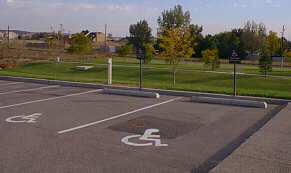 Albuquerque's Environmental Story
Albuquerque's Environmental Story
Educating For a Sustainable Community
Environmental Topic: Physical Accessibility
by Richard Hammond and Diana Trujillo
Background
Section 504 of the Rehabilitation Act was enacted into law in 1973 as
the first civil rights law guaranteeing equal opportunity to America's disabled.
Its language is similar to Title IV of the Civil Rights Act of 1964,
which prohibits discrimination on the basis of race, color or national origin,
and Title IX of the Education Amendments of 1972, which prohibits discrimination
on the basis of sex. Congress mandated the following:
"No otherwise qualified handicapped individual in the United States
. . . shall, solely by reason of his handicap, be excluded from participation
in, be denied benefits of, or be subjected to discrimination under any program
or activity receiving Federal assistance" (Public Interest Law Center
of Philadelphia, June 1977)
Accessibility
 |
In 1977, the Health, Education and Welfare Department was the first federal
agency to issue regulations to implement Section 504. Those regulations provided
the framework for bringing about such fundamental changes as removing architectural
barriers, providing effective communication for the blind and the deaf, and
accommodating the needs of disabled people at the work place and in the class
room.
Section 504 provided no penalties to enforce these laws in the private sector
and to a great extent in the public sector.
The Americans with Disabilities Act (ADA), enacted in 1990, prohibits
discrimination against persons with disabilities in employment, public accommodations,
transportation, state and local government services and telecommunications.
As civil rights legislation, the ADA guarantees protection comparable with that
previously afforded other groups based on race, sex, national origin, age and
religion.
Those guidelines for accessibility include specific measurements for door widths,
heights, distances and angles for ramps, and other solutions for problems related
to accessibility. Lawmakers are in the process of clarifying the requirements
of ADA because the current language is vague.
The City of Albuquerque has made great strides in the areas of ensuring equal
rights to all people regardless of race, gender, sexual preference, religious
beliefs or disabilities. The City continues to make progress by enforcing ADA
requirements and educating the public about ADA and disabilities.
Universal Trail Design
Courtesy of RT Graphics
Rio Rancho, NM
 |
Those responsible for designing recreational trails accessible to persons with
disabilities and those involved in interpretation and education work to incorporate
universal design into the planning process. They know that people have different
learning styles, i.e., some are visual learners and want to see it for "it"
to make sense. Others must hear it, some must touch it.
Anything that benefits persons with disabilities benefits all who use the facility.
Universal trail design includes such features as tactile exhibits, e.g., a model
of a mountain or a bird--with texture and other elements that give an idea of
proportion to the visually impaired--also serves people with perfect vision.
Audio tapes are useful to most audiences. Most people can the enjoy pictures
and exhibits with simple text and models of animals; everybody appreciates the
many benches, shady rest areas and nonslip surfaces. Self-guided tours that
inform and stimulate the senses make recreational trails safe and enjoyable
for all.
The following is a list of individuals and organizations with information on
disability-related issues:
- Disability liaison for the City of Albuquerque, 768-3734
- ADA coordinator for the City, 768-3759
- New Mexico Commission for the Blind, 841-8844
- New Mexico School for the Deaf, Santa Fe, (505) 827-6714 Voice-TTD (505)
827-6711
- Coalition for Disability Rights, Santa Fe, (505) 982-0140
- City/County Commission on Persons with Disabilities, mayor's office, 768-3000
- NM Dept. of Education, Div. of Vocational Rehabilitation, Santa Fe (505)
827-3511
- Developmental Disabilities Planning Council, Santa Fe (505) 827-7590
- Independent Living Resource Center, 266-5022
- National Center on Accessibility, Indiana University, Dept. of Recreation
& Parks Administration, Bradford Woods Outdoor Center; 5040 State Rd.
67 North; Martinsville, IN; 46151. (317) 349-9240 Voice TTD 1-800-424-1877.
Options and Opinions
Discussion Questions
- What should be done about nondisabled people who park in handicap parking
spaces?
- Why is the term "disability" a better one to use for people with
impairments than "handicapped?" How is each of them defined by the
United Nations in its disability policy? **
Possible Solutions/Opinions
- Audible light signals should be installed at busy intersections to make
it easier for blind persons to cross the street.
- Society in general benefits when the environment is modified to accommodate
the needs of people with disabilities.
Activities
- Although no amount of imagining or simulation could ever really convey
to a person without disabilities what it is like to be physically impaired,
role playing for a brief time could develop some understanding of the problems
encountered. Students might volunteer to spend an hour or two either at home
or at school blindfolded, or wearing ear plugs or using a wheel chair. Some
might just tape their thumbs to their fingers in order to see what it feels
like to be deprived of some of their normal capabilities. During the role
playing, they should record their feelings and thoughts either by writing
them down, talking into a tape recorder, or sharing them with a "buddy."
Class discussion following this exercise might lead to a study of the Americans
with Disabilities Act (ADA)and why it is important.
- Most schools and public buildings were retrofitted in the nineties with
doors that can be opened by pushing a button. Use this accommodation for the
physically impaired to discuss the ADA. Students might investigate what it
is, why it was enacted, what specific amenities it provides, etc. They might
compile a list, based on their observations, of the adjustments that have
been made in the built environment to make facilities more accessible for
people with disabilities (special parking spaces, restroom facilities, lower
water fountains, ramps, etc.) On another chart students might list, again
on the basis of their experience, places where the physically impaired still
are not able to enjoy all the advantages a facility can offer (driveways and
broken sidewalks that are inaccessible to wheelchairs, windows that are too
high to be opened from a wheelchair, narrow doorways, etc.) Students might
contact AMREP Southwest, a home construction company, to learn about the adjustments
they have made in homes for people with wheelchairs.
- Contact the U.S. Fish and Wildlife Department (248-6821) for information
on setting up an interpretive trail and displays for physically (visually,
hearing, or otherwise disabled) persons. Design an interpretive trail for
part of the school grounds. Consider such factors as providing tactile and
olfactory experiences, auditory explanations, setting up safe and readily
accessible paths, etc. Make a 3-D model of this interpretive trail. If feasible,
raise money and seek volunteer adult assistance to construct this trail on
the school grounds.
- Conduct research to find out how people in other countries (e.g., the former
Soviet Union) and other periods in history (e.g., the time of the ancient
Greeks)provided for people with disabilities. Compare with provisions in the
U.S. before the ADA was enacted (1977) and since.
- Design a home that could meet the needs of a person who uses a wheelchair.
Consider such factors as height of cabinets, tops of windows, location of
wall sockets, etc. Students might use both the information from AMREP Southwest
and the notes from their own experiences (being blindfolded or confined to
a wheelchair, wearing earplugs, etc.)
(Up to Section V, Back to Open
Space,
On to Population
Growth)
Copyright © 2008, Friends of Albuquerque's Environmental Story

